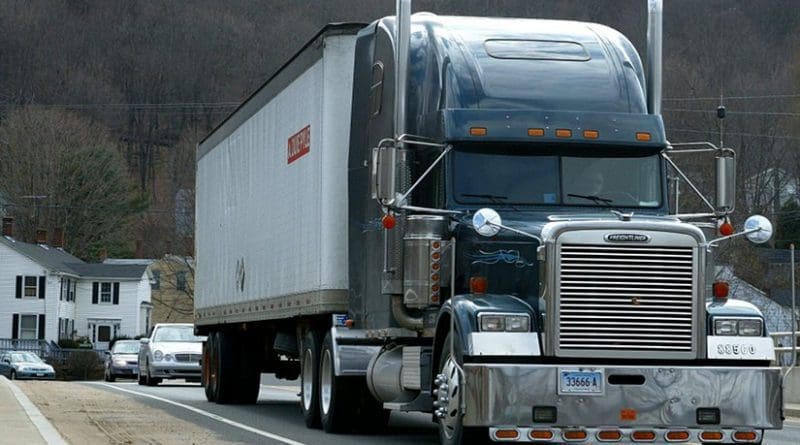US Truck Drivers Brace For The Bot Onslaught – OpEd
By Daniel Cohen
On Thursday of last week, Tesla unveiled its long-awaited big rig truck and made the long-established hauling industry the latest business to occupy the auto maker’s crosshairs. Tesla’s move into the tractor trailer industry is a big leap for the sleek car manufacturer, but a reasonable one. The company is fueled—pardon the pun—by a desire to switch the world’s drivers away from the internal combustion engine and towards an electric vehicle while simultaneously creating a massive solar panel and battery infrastructure of the future. The move into big rigs is a logical step toward an electric-driven, reduced-emission future considering the fact that heavy duty trucks account for a substantial share of the world’s greenhouse gasses.
Curbing such a significant source of pollution is a noble task. But with each new electric truck that Tesla rolls out, another vehicle equipped with an “autopilot” system hits the streets. According to Tesla CEO Elon Musk, the adoption of autonomous driving vehicles—which can automatically engage braking systems and alert drivers to lane departures—will increase safety and hopefully reduce the roughly 4,000 annual deaths in truck-related accidents. While today’s systems are only “semi-autonomous,” we are not far from a future of fully self-driving automobiles. What repercussions loom around the bend once long-haul truckers—who account for more than 5% of the American work force—are suddenly out of commission? We’ve seen what the collapse of the coal industry has done throughout Appalachia. But the collapse of an industry of roughly 80,000 workers is nothing compared to the challenges that await around the bend as more than 3.1 million drivers find themselves at risk of automation.
“Drivers will become more like fleet managers,” Musk recently said about the coming transition in the trucking industry. And from the head of what is essentially a technology, energy, and auto company rolled into one, that’s a smart position to take. First of all, it implies that today’s truckers will keep their jobs. Second, these next-wave trucking jobs will be better, higher-paying managerial roles. That’s precisely the narrative the automotive industry wants to push in an effort to get the public, transit companies, labor unions, and government regulators to help create an environment for the transition to self-driving autos. Unfortunately, the road to this utopia is long and complex. The reality will be much different and nothing quite so neat and tidy as simply retraining truckers to manage self-driving fleets.
In the short-to-medium term, the extant trucking industry will be involved in the transition, but the economics work out to a massive de-valuation of truck-drivers’ skills and most probably (at least without expensive and invasive federal interference) wholesale replacement of truck drivers in the labor market, i.e. the elimination of their jobs and the creation of a new, less labor-intensive industry that channels money to technology and away from labor. The solution is not as simple as, “Hey, let’s retrain truckers!” Just listen to what Musk and other auto executives have to say on the subject and it’s easy to find holes in their narrative.
First, big auto says they don’t need a driver in a self-driving truck, just a lowly systems control technician who can eventually be relocated to a control center. Next, they say that person doesn’t need to have any qualifications so they could fill that position with monkeys earning one dollar per hour. Sure, regulation will create lots of jobs to deal with the red tape, but take a second and look at the fundamental value proposition of self-driving: eliminate costs by eliminating labor and human error. It can take many paths, but all of them will end up with a safer, cheaper, more efficient shipping industry—and a truckload of unemployed long-haulers.
Not everyone sees the trucking landscape of tomorrow as a nightmare. Last month, the Oracle of Omaha Warren Buffet made a major bet on truck stops as his Berkshire Hathaway purchased a minority share in roadside rest stop company Pilot Flying J (Berkshire’s stake will increase to 80% in 2023). While automation is coming (though not soon according to Pilot CEO Jimmy Haslam), some analysts believe future regulations limiting the number of hours drivers can log will prompt more stops at facilities and boost Pilot’s profits in the near-to-medium term.
So, what is to be done to mitigate the inevitable impact of technological advancement? Like other industries threatened by automation, worker retraining is elemental. To finance this reinvestment in the American worker, we might consider the calls of Bill Gates and institute a “robot” tax. Such a proposal might perhaps not only bankroll the cost of retraining, but it may also slow down automation adoption, as companies will be forced consider the tax implications of such a move.
Throughout his campaign, President Trump promised a new era of prosperity for America’s coal workers, all while wearing a trucker hat with his infamous “Make America Great Again” slogan. If the commander in chief wants to protect millions of American jobs, perhaps he should turn his attention to the industry from which his headwear gets its name.
The opinions, beliefs, and viewpoints expressed by the authors are theirs alone and don’t reflect any official position of Geopoliticalmonitor.com.

